Climate Change Effects on Rainfall Intensity–Duration–Frequency (IDF) Curves for the Lake Erie Coast Using Various Climate Models
Abstract
:1. Introduction
2. Theoretical Description
2.1. CMIP5 Data Set
2.2. CMIP6 Data Set
2.3. Bias Correction
2.4. Intensity Duration Frequency (IDF) Curves
3. Materials and Methods
3.1. Study Area
3.2. Climate Model Data
3.3. Bias Correction of Raw Data
3.4. Development of the IDF Curve
4. Results and Discussion
4.1. CMIP5
4.2. CMIP6
4.3. CMIP5 vs. CMIP6: A Comparison
5. Conclusions
Author Contributions
Funding
Data Availability Statement
Acknowledgments
Conflicts of Interest
References
- IPCC. Climate Change 2007: Synthesis Report Summary for Policymakers; An Assessment of the Intergovernmental Panel on Climate Change; IPCC: Geneva, Switzerland, 2007. [Google Scholar]
- IPCC. Climate Change 2014: Synthesis Report; Longer Report; IPCC: Geneva, Switzerland, 2014. [Google Scholar]
- Allen, M.R.; Ingram, W.J. Insight Review Articles 224. 2002. Available online: www.nature.com/nature (accessed on 1 January 2022).
- Swain, D.L.; Wing, O.E.J.; Bates, P.D.; Done, J.M.; Johnson, K.A.; Cameron, D.R. Increased Flood Exposure Due to Climate Change and Population Growth in the United States. Earth’s Future 2020, 8, e2020EF001778. [Google Scholar] [CrossRef]
- Tabari, H. Climate change impact on flood and extreme precipitation increases with water availability. Sci. Rep. 2020, 10, 13768. [Google Scholar] [CrossRef] [PubMed]
- Trenberth, K.E.; Dai, A.; Rasmussen, R.M.; Parsons, D.B. The Changing character of precipitation. Bull. Am. Meteorol. Soc. 2003, 84, 1205–1218. [Google Scholar] [CrossRef]
- Haerter, J.O.; Berg, P. Unexpected rise in extreme precipitation caused by a shift in rain type? Nat. Geosci. 2009, 2, 372–373. [Google Scholar] [CrossRef]
- Lenderink, G.; Van Meijgaard, E. Increase in hourly precipitation extremes beyond expectations from temperature changes. Nat. Geosci. 2008, 1, 511–514. [Google Scholar] [CrossRef]
- Westra, S.; Fowler, H.J.; Evans, J.P.; Alexander, L.V.; Berg, P.; Johnson, F.; Kendon, E.J.; Lenderink, G.; Roberts, N.M. Future changes to the intensity and frequency of short-duration extreme rainfall. In Reviews of Geophysics; Blackwell Publishing Ltd.: Hoboken, NJ, USA, 2014; Volume 52, pp. 522–555. [Google Scholar] [CrossRef]
- Prein, A.F.; Rasmussen, R.M.; Ikeda, K.; Liu, C.; Clark, M.P.; Holland, G.J. The future intensification of hourly precipitation extremes. Nat. Clim. Chang. 2017, 7, 48–52. [Google Scholar] [CrossRef]
- Easterling, D.R.; Meehl, G.A.; Parmesan, C.; Changnon, S.A.; Karl, T.R.; Mearns, L.O. Climate Extremes: Observations, Modeling, and Impacts. Science 2000, 289, 2068–2074. [Google Scholar] [CrossRef]
- Groisman, P.Y.; Knight, R.W.; Easterling, D.R.; Karl, T.R.; Hegerl, G.C.; Razuvaev, V.N. Trends in Intense Precipitation in the Climate Record. J. Clim. 2005, 18, 1326–1350. [Google Scholar] [CrossRef]
- Kourtis, I.M.; Tsihrintzis, V.A. Update of intensity-duration-frequency (IDF) curves under climate change: A review. Water Supply 2022, 22, 4951–4974. [Google Scholar] [CrossRef]
- Cook, L.M.; McGinnis, S.; Samaras, C. The effect of modeling choices on updating intensity-duration-frequency curves and stormwater infrastructure designs for climate change. Clim. Chang. 2020, 159, 289–308. [Google Scholar] [CrossRef]
- Thakali, R.; Kalra, A.; Ahmad, S. Understanding the effects of climate change on urban stormwater infrastructures in the Las Vegas Valley. Hydrology 2016, 3, 34. [Google Scholar] [CrossRef]
- Guo, Y.; Asce, M. Updating Rainfall IDF Relationships to Maintain Urban Drainage Design Standards. J. Hydrol. Eng. 2006, 11, 506–509. [Google Scholar] [CrossRef]
- Liu, L. The dynamics of early-stage transmission of COVID-19: A novel quantification of the role of global temperature. Gondwana Res. 2023, 114, 55–68. [Google Scholar] [CrossRef] [PubMed]
- Martel, J.-L.; Brissette, F.P.; Lucas-Picher, P.; Troin, M.; Arsenault, R. Climate Change and Rainfall Intensity–Duration–Frequency Curves: Overview of Science and Guidelines for Adaptation. J. Hydrol. Eng. 2021, 26, 03121001. [Google Scholar] [CrossRef]
- Mohammed, A.; Dan’Azumi, S.; Modibbo, A.A.; Adamu, A.A. Development of Rainfall Intensity Duration Frequency (IDF) Curves for Design of Hydraulic Structures in Kano State, Nigeria. Platform 2021, 5, 10–22. [Google Scholar]
- Elsebaie, I.H. Developing rainfall intensity–duration–frequency relationship for two regions in Saudi Arabia. J. King Saud Univ.-Eng. Sci. 2012, 24, 131–140. [Google Scholar] [CrossRef]
- Kundwa, M.J. Development of Rainfall Intensity Duration Frequency (IDF) Curves for Hydraulic Design Aspect. J. Ecol. Nat. Resour. 2019, 3, 1–14. [Google Scholar] [CrossRef]
- Rashid, M.; Faruque, S.; Rashid, M.M.; Faruque, S.B.; Alam, J.B. Modeling of Short Duration Rainfall Intensity Duration Frequency (SDR-IDF) Equation for Sylhet City in Bangladesh Statistical Downscaling of GCM Outputs to Rainfall View Project Extreme Sea Level Variations along the U.S. Coastlines View Project Modeling of Short Duration Rainfall Intensity Duration Frequency (SDR-IDF) Equation for Sylhet City in Bangladesh. 2. 2012. Available online: http://www.ejournalofscience.org (accessed on 1 January 2022).
- Singh, R.; Arya, D.S.; Taxak, A.K.; Vojinovic, Z. Potential Impact of Climate Change on Rainfall Intensity-Duration-Frequency Curves in Roorkee, India. Water Resour. Manag. 2016, 30, 4603–4616. [Google Scholar] [CrossRef]
- Prodanovic, P.; Simonovic, S.P. The university of western ontario department of civil and environmental engineering. In Water Resources Research Report; John Wiley & Sons: Hoboken, NJ, USA, 2007. [Google Scholar]
- Srivastav, R.K.; Schardong, A.; Simonovic, S.P. Equidistance Quantile Matching Method for Updating IDFCurves under Climate Change. Water Resour. Manag. 2014, 28, 2539–2562. [Google Scholar] [CrossRef]
- Hess, J.J.; Malilay, J.N.; Parkinson, A.J. Climate Change. The Importance of Place. Am. J. Prev. Med. 2008, 35, 468–478. [Google Scholar] [CrossRef]
- Hosseinzadehtalaei, P.; Tabari, H.; Willems, P. Climate change impact on short-duration extreme precipitation and intensity–duration–frequency curves over Europe. J. Hydrol. 2020, 590, 125249. [Google Scholar] [CrossRef]
- Peck, A.; Prodanovic, P.; Simonovic, S.P. Rainfall intensity duration frequency curves under climate change: City of London, Ontario, Canada. Can. Water Resour. J. 2012, 37, 177–189. [Google Scholar] [CrossRef]
- Trenberth, K.E. Changes in precipitation with climate change. Clim. Res. 2011, 47, 123–138. [Google Scholar] [CrossRef]
- Rodríguez, R.; Navarro, X.; Casas, M.C.; Ribalaygua, J.; Russo, B.; Pouget, L.; Redaño, A. Influence of climate change on IDF curves for the metropolitan area of Barcelona (Spain). Int. J. Climatol. 2014, 34, 643–654. [Google Scholar] [CrossRef]
- Shrestha, A.; Babel, M.S.; Weesakul, S.; Vojinovic, Z. Developing Intensity-Duration-Frequency (IDF) curves under climate change uncertainty: The case of Bangkok, Thailand. Water 2017, 9, 145. [Google Scholar] [CrossRef]
- Shrestha, S.; Sharma, S. Assessment of climate change impact on high flows in a watershed characterized by flood regulating reservoirs. Int. J. Agric. Biol. Eng. 2021, 14, 178–191. [Google Scholar] [CrossRef]
- Ghasemi Tousi, E.; O’Brien, W.; Doulabian, S.; Shadmehri Toosi, A. Climate changes impact on stormwater infrastructure design in Tucson Arizona. Sustain. Cities Soc. 2021, 72, 103014. [Google Scholar] [CrossRef]
- Lopez-Cantu, T.; Prein, A.F.; Samaras, C. Uncertainties in Future U.S. Extreme Precipitation from Downscaled Climate Projections. Geophys. Res. Lett. 2020, 47, e2019GL086797. [Google Scholar] [CrossRef]
- Chen, H.; Sun, J.; Lin, W.; Xu, H. Comparison of CMIP6 and CMIP5 models in simulating climate extremes. In Science Bulletin; Elsevier B.V.: Amsterdam, The Netherlands, 2020; Volume 65, pp. 1415–1418. [Google Scholar] [CrossRef]
- Thibeault, J.M.; Seth, A. Changing climate extremes in the Northeast United States: Observations and projections from CMIP5. Clim. Chang. 2014, 127, 273–287. [Google Scholar] [CrossRef]
- Ragno, E.; AghaKouchak, A.; Love, C.A.; Cheng, L.; Vahedifard, F.; Lima, C.H.R. Quantifying Changes in Future Intensity-Duration-Frequency Curves Using Multimodel Ensemble Simulations. Water Resour. Res. 2018, 54, 1751–1764. [Google Scholar] [CrossRef]
- Cheng, L.; Aghakouchak, A. Nonstationary precipitation intensity-duration-frequency curves for infrastructure design in a changing climate. Sci. Rep. 2014, 4, 7093. [Google Scholar] [CrossRef] [PubMed]
- Coelho, G.d.A.; Ferreira, C.M.; Johnston, J.; Kinter, J.L.; Dollan, I.J.; Maggioni, V. Potential Impacts of Future Extreme Precipitation Changes on Flood Engineering Design Across the Contiguous United States. Water Resour. Res. 2022, 58, e2021WR031432. [Google Scholar] [CrossRef]
- Lee, J.W.; Hong, S.Y.; Chang, E.C.; Suh, M.S.; Kang, H.S. Assessment of future climate change over East Asia due to the RCP scenarios downscaled by GRIMs-RMP. Clim. Dyn. 2014, 42, 733–747. [Google Scholar] [CrossRef]
- Rummukainen, M. Added value in regional climate modeling. Wiley Interdiscip. Rev. Clim. Chang. 2016, 7, 145–159. [Google Scholar] [CrossRef]
- Park, J.H.; Oh, S.G.; Suh, M.S. Impacts of boundary conditions on the precipitation simulation of RegCM4 in the CORDEX East Asia domain. J. Geophys. Res. Atmos. 2013, 118, 1652–1667. [Google Scholar] [CrossRef]
- Qian, Y.; Ghan, S.J.; Leung, L.R. Downscaling hydroclimatic changes over the western US based on CAM subgrid scheme and WRF regional climate simulations. Int. J. Climatol. 2010, 30, 675–693. [Google Scholar] [CrossRef]
- O’Neill, B.C.; Tebaldi, C.; Van Vuuren, D.P.; Eyring, V.; Friedlingstein, P.; Hurtt, G.; Knutti, R.; Kriegler, E.; Lamarque, J.F.; Lowe, J.; et al. The Scenario Model Intercomparison Project (ScenarioMIP) for CMIP6. Geosci. Model Dev. 2016, 9, 3461–3482. [Google Scholar] [CrossRef]
- Giorgi, F.; Jones, C.; Asrar, G.R. Addressing climate information needs at the regional level: The CORDEX framework. WMO Bull. 2009, 58, 175. [Google Scholar]
- Gutowski, J.W.; Giorgi, F.; Timbal, B.; Frigon, A.; Jacob, D.; Kang, H.S.; Raghavan, K.; Lee, B.; Lennard, C.; Nikulin, G.; et al. WCRP COordinated Regional Downscaling EXperiment (CORDEX): A diagnostic MIP for CMIP6. Geosci. Model Dev. 2016, 9, 4087–4095. [Google Scholar] [CrossRef]
- McGinnis, S.; Mearns, L. Building a climate service for North America based on the NA-CORDEX data archive. Clim. Serv. 2021, 22, 100233. [Google Scholar] [CrossRef]
- Gutowski, W.J.; Ullrich, P.A.; Hall, A.; Leung, L.R.; O’Brien, T.A.; Patricola, C.M.; Arritt, R.W.; Bukovsky, M.S.; Calvin, K.V.; Feng, Z.; et al. The ongoing need for high-resolution regional climate models: Process understanding and stakeholder information. Bull. Am. Meteorol. Soc. 2021, 101, E664–E683. [Google Scholar] [CrossRef]
- Kirtman, B.; Pirani, A. The State of the Art of Seasonal Prediction: Outcomes and Recommendations from the First World Climate Research Program Workshop on Seasonal Prediction. Bull. Am. Meteorol. Soc. 2009, 90, 455–458. [Google Scholar] [CrossRef]
- Moss, R.H.; Edmonds, J.A.; Hibbard, K.A.; Manning, M.R.; Rose, S.K.; van Vuuren, D.P.; Carter, T.R.; Emori, S.; Kainuma, M.; Kram, T.; et al. The next generation of scenarios for climate change research and assessment. Nature 2010, 463, 747–756. [Google Scholar] [CrossRef] [PubMed]
- Bruyère, C.L.; Done, J.M.; Holland, G.J.; Fredrick, S. Bias corrections of global models for regional climate simulations of high-impact weather. Clim. Dyn. 2014, 43, 1847–1856. [Google Scholar] [CrossRef]
- Donat, M.G.; Lowry, A.L.; Alexander, L.V.; O’Gorman, P.A.; Maher, N. More extreme precipitation in the worldâ €TM s dry and wet regions. Nat. Clim. Chang. 2016, 6, 508–513. [Google Scholar] [CrossRef]
- Gao, X.-J.; Wang, M.-L.; Giorgi, F. Climate Change over China in the 21st Century as Simulated by BCC_CSM1.1-RegCM4.0. Atmos. Ocean. Sci. Lett. 2013, 6, 381–386. [Google Scholar] [CrossRef]
- Maraun, D.; Shepherd, T.G.; Widmann, M.; Zappa, G.; Walton, D.; Gutiérrez, J.M.; Hagemann, S.; Richter, I.; Soares, P.M.M.; Hall, A.; et al. Towards process-informed bias correction of climate change simulations. Nat. Clim. Chang. 2017, 7, 764–773. [Google Scholar] [CrossRef]
- Mehrotra, R.; Sharma, A. An improved standardization procedure to remove systematic low frequency variability biases in GCM simulations. Water Resour. Res. 2012, 48. [Google Scholar] [CrossRef]
- Xu, Z.; Yang, Z.L. An improved dynamical downscaling method with GCM bias corrections and its validation with 30 years of climate simulations. J. Clim. 2012, 25, 6271–6286. [Google Scholar] [CrossRef]
- Acharya, N.; Chattopadhyay, S.; Mohanty, U.C.; Dash, S.K.; Sahoo, L.N. On the bias correction of general circulation model output for Indian summer monsoon. Meteorol. Appl. 2013, 20, 349–356. [Google Scholar] [CrossRef]
- Wood, A.W.; Leung, L.R.; Sridhar, V.; Lettenmaier, D.P. Hydrologic Implications of dynamical and statistical approaches to downscaling climate model outputs. Clim. Chang. 2004, 62, 189–216. [Google Scholar] [CrossRef]
- Abatzoglou, J.T.; Brown, T.J. A comparison of statistical downscaling methods suited for wildfire applications. Int. J. Climatol. 2012, 32, 772–780. [Google Scholar] [CrossRef]
- Chen, J.; Brissette, F.P.; Chaumont, D.; Braun, M. Finding appropriate bias correction methods in downscaling precipitation for hydrologic impact studies over North America. Water Resour. Res. 2013, 49, 4187–4205. [Google Scholar] [CrossRef]
- Gudmundsson, L.; Bremnes, J.B.; Haugen, J.E.; Engen-Skaugen, T. Technical Note: Downscaling RCM precipitation to the station scale using statistical transformations – A comparison of methods. Hydrol. Earth Syst. Sci. 2012, 16, 3383–3390. [Google Scholar] [CrossRef]
- Maraun, D. Bias Correcting Climate Change Simulations—A Critical Review. In Current Climate Change Reports; Springer: Berlin/Heidelberg, Germany, 2016; Volume 2, pp. 211–220. [Google Scholar] [CrossRef]
- Maraun, D.; Wetterhall, F.; Ireson, A.M.; Chandler, R.E.; Kendon, E.J.; Widmann, M.; Brienen, S.; Rust, H.W.; Sauter, T.; Themel, M.; et al. Precipitation downscaling under climate change: Recent developments to bridge the gap between dynamical models and the end user. Rev. Geophys. 2010, 48, 1–34. [Google Scholar] [CrossRef]
- Pierce, D.W.; Cayan, D.R.; Thrasher, B.L. Statistical Downscaling Using Localized Constructed Analogs (LOCA). J. Hydrometeorol. 2014, 15, 2558–2585. [Google Scholar] [CrossRef]
- Tabari, H.; Paz, S.M.; Buekenhout, D.; Willems, P. Comparison of statistical downscaling methods for climate change impact analysis on precipitation-driven drought. Hydrol. Earth Syst. Sci. 2021, 25, 3493–3517. [Google Scholar] [CrossRef]
- Grose, M.R.; Post, D.A.; Ling, F.L.N.; Corney, S.; Bennett, J.C.; Grose, M.R.; Post, D.A.; Ling, F.L.N.; Corney, S.P.; Bindoff, N.L. Performance of Quantile-Quantile Bias-Correction for Use in Hydroclimatological Projections Bioregional Assessment Programme View Project Barwon Water Inflows under Climate Change View Project Performance of Quantile-Quantile Bias-correction for Use in Hydroclimatological Projections. 2011. Available online: http://mssanz.org.au/modsim2011 (accessed on 1 January 2022).
- Hayhoe, K.; Wake, C.; Anderson, B.; Liang, X.Z.; Maurer, E.; Zhu, J.; Bradbury, J.; Degaetano, A.; Stoner, A.M.; Wuebbles, D. Regional climate change projections for the Northeast USA. Mitig. Adapt. Strateg. Glob. Chang. 2008, 13, 425–436. [Google Scholar] [CrossRef]
- Maurer, E.P.; Duffy, P.B. Uncertainty in projections of streamflow changes due to climate change in California. Geophys. Res. Lett. 2005, 32, 1–5. [Google Scholar] [CrossRef]
- Li, H.; Sheffield, J.; Wood, E.F. Bias correction of monthly precipitation and temperature fields from Intergovernmental Panel on Climate Change AR4 models using equidistant quantile matching. J. Geophys. Res. Atmos. 2010, 115. [Google Scholar] [CrossRef]
- Maurer, E.P.; Pierce, D.W. Bias correction can modify climate model simulated precipitation changes without adverse effect on the ensemble mean. Hydrol. Earth Syst. Sci. 2014, 18, 915–925. [Google Scholar] [CrossRef]
- Obaid, N.; Alghazali, S.; Adnan, D.; Alawadi, H. Fitting Statistical Distributions of Monthly Rainfall for Some Iraqi Stations. Civ. Environ. Res. 2014, 6, 40–46. [Google Scholar]
- AlHassoun, S.A. Developing an empirical formulae to estimate rainfall intensity in Riyadh region. J. King Saud Univ.-Eng. Sci. 2011, 23, 81–88. [Google Scholar] [CrossRef]
- Hailegeorgis, T.T.; Thorolfsson, S.T.; Alfredsen, K. Regional frequency analysis of extreme precipitation with consideration of uncertainties to update IDF curves for the city of Trondheim. J. Hydrol. 2013, 498, 305–318. [Google Scholar] [CrossRef]
- Al Islam, M.; Hasan, H. Generation of IDF equation from catchment delineation using GIS. Civ. Eng. J. 2020, 6, 540–547. [Google Scholar] [CrossRef]
- Mujere, N. Flood Frequency Analysis Using the Gumbel Distribution. Int. J. Comput. Sci. Eng. 2011, 3, 2774–2778. [Google Scholar]
- Solomon, O.; Prince, O. Flood Frequency Analysis of Osse River Using Gumbel’s Distribution. Civ. Environ. Res. 2013, 3, 55–59. [Google Scholar]
- Vidal, I. A Bayesian analysis of the Gumbel distribution: An application to extreme rainfall data. Stoch. Environ. Res. Risk Assess. 2014, 28, 571–582. [Google Scholar] [CrossRef]
- Tahir, W.; Bakar, S.H.A.; Wahid, M.A.; Nasir, S.R.M.; Lee, W.K. ISFRAM 2015; Springer: Singapore, 2016. [Google Scholar] [CrossRef]
- Yong, S.L.S.; Ng, J.L.; Huang, Y.F.; Ang, C.K. Assessment of the best probability distribution method in rainfall frequency analysis for a tropical region. Malays. J. Civ. Eng. 2021, 33. [Google Scholar] [CrossRef]
- Balakrishnan, N.; Cramer, E.; Kundu, D. Hybrid Censoring Know-How: Designs and Implementations; Academic Press: Chicago, IL, USA, 2023. [Google Scholar]
- Bartels, R.J.; Black, A.W.; Keim, B.D. Trends in precipitation days in the United States. Int. J. Climatol. 2020, 40, 1038–1048. [Google Scholar] [CrossRef]
- Gupta, R.; Bhattarai, R.; Mishra, A. Development of climate data bias corrector (CDBC) tool and its application over the agro-ecological zones of India. Water 2019, 11, 1102. [Google Scholar] [CrossRef]
- Ayugi, B.; Shilenje, Z.W.; Babaousmail, H.; Lim Kam Sian, K.T.C.; Mumo, R.; Dike, V.N.; Iyakaremye, V.; Chehbouni, A.; Ongoma, V. Projected changes in meteorological drought over East Africa inferred from bias-adjusted CMIP6 models. Nat. Hazards 2022, 113, 1151–1176. [Google Scholar] [CrossRef] [PubMed]
- Babaousmail, H.; Ayugi, B.; Rajasekar, A.; Zhu, H.; Oduro, C.; Mumo, R.; Ongoma, V. Projection of Extreme Temperature Events over the Mediterranean and Sahara Using Bias-Corrected CMIP6 Models. Atmosphere 2022, 13, 741. [Google Scholar] [CrossRef]
- Babaousmail, H.; Hou, R.; Ayugi, B.; Sian, K.T.C.L.K.; Ojara, M.; Mumo, R.; Chehbouni, A.; Ongoma, V. Future changes in mean and extreme precipitation over the Mediterranean and Sahara regions using bias-corrected CMIP6 models. Int. J. Climatol. 2022, 42, 7280–7297. [Google Scholar] [CrossRef]
- Lim Kam Sian, K.T.C.; Hagan, D.F.T.; Ayugi, B.O.; Nooni, I.K.; Ullah, W.; Babaousmail, H.; Ongoma, V. Projections of precipitation extremes based on bias-corrected Coupled Model Intercomparison Project phase 6 models ensemble over southern Africa. Int. J. Climatol. 2022, 42, 8269–8289. [Google Scholar] [CrossRef]
- Shrestha, S.; Sharma, S.; Gupta, R.; Bhattarai, R. Impact of global climate change on stream low flows: A case study of the great Miami river Watershed, Ohio. Int. J. Agric. Biol. Eng. 2019, 12, 84–95. [Google Scholar] [CrossRef]
- Xue, P.; Ye, X.; Pal, J.S.; Chu, P.Y.; Kayastha, M.B.; Huang, C. Climate projections over the Great Lakes Region: Using two-way coupling of a regional climate model with a 3-D lake model. Geosci. Model Dev. 2022, 15, 4425–4446. [Google Scholar] [CrossRef]
- Zhang, L.; Zhao, Y.; Hein-Griggs, D.; Janes, T.; Tucker, S.; Ciborowski, J.J.H. Climate change projections of temperature and precipitation for the great lakes basin using the PRECIS regional climate model. J. Great Lakes Res. 2020, 46, 255–266. [Google Scholar] [CrossRef]
- Minallah, S.; Steiner, A.L. Analysis of the Atmospheric Water Cycle for the Laurentian Great Lakes Region Using CMIP6 Models. J. Clim. 2021, 34, 4693–4710. [Google Scholar] [CrossRef]
- Briley, L.J.; Rood, R.B.; Notaro, M. Large lakes in climate models: A Great Lakes case study on the usability of CMIP5. J. Great Lakes Res. 2021, 47, 405–418. [Google Scholar] [CrossRef]
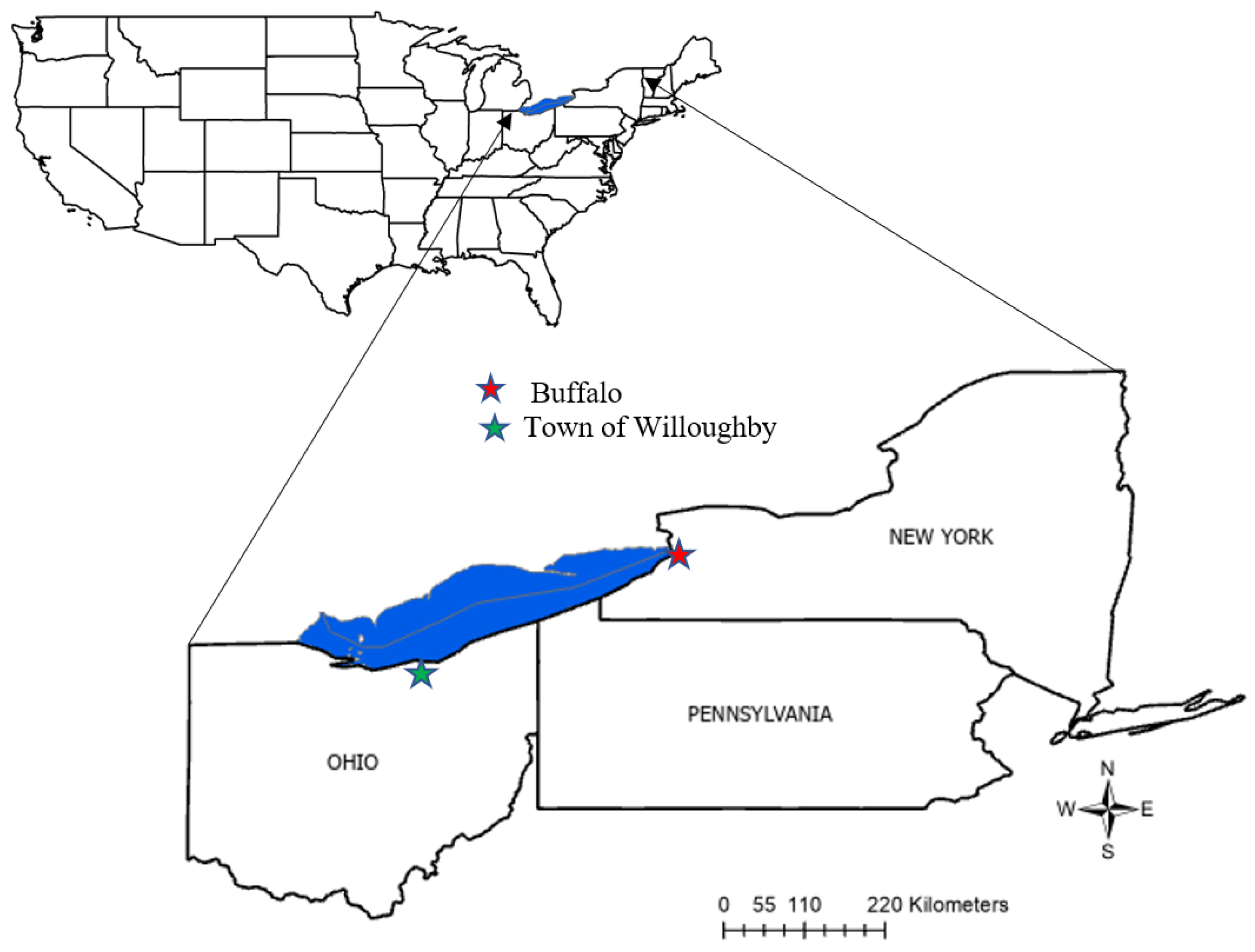

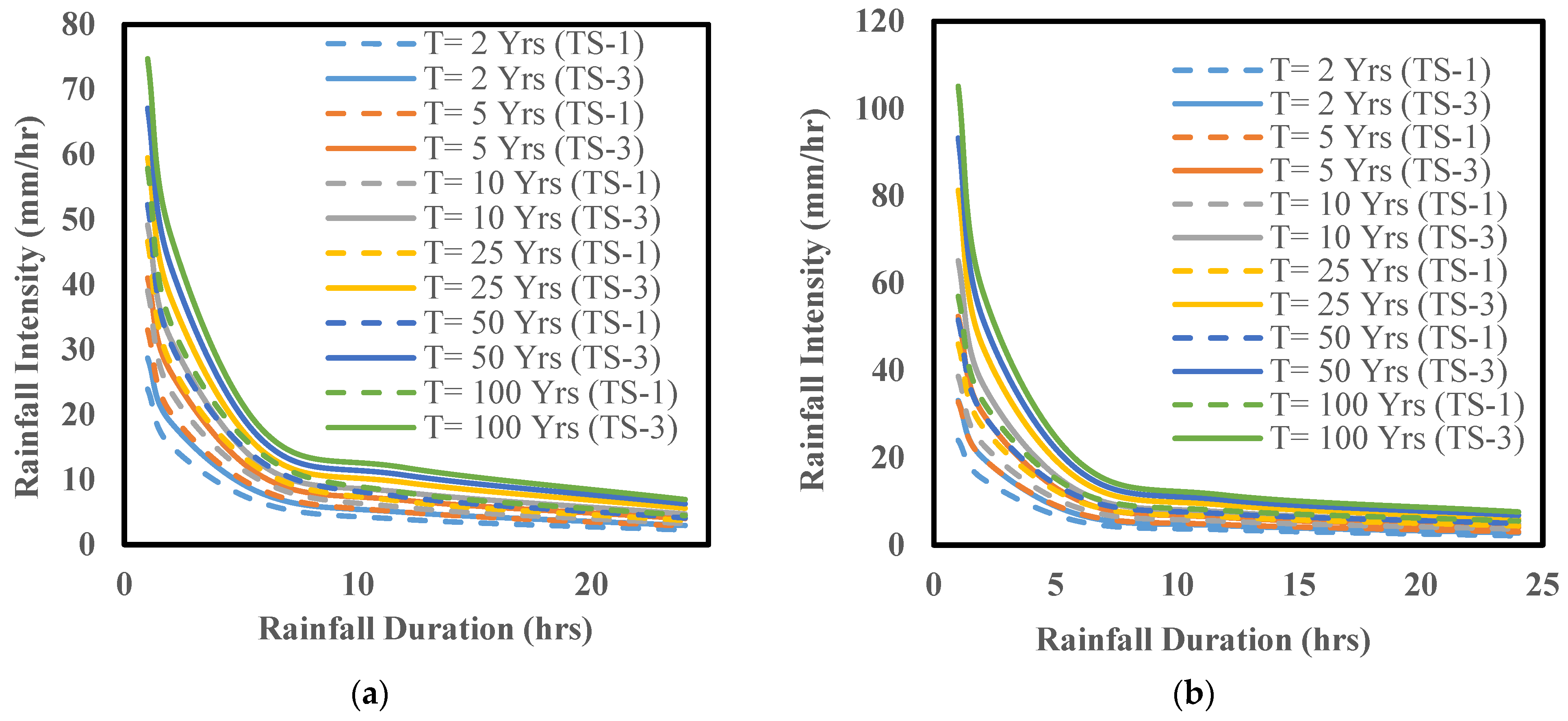


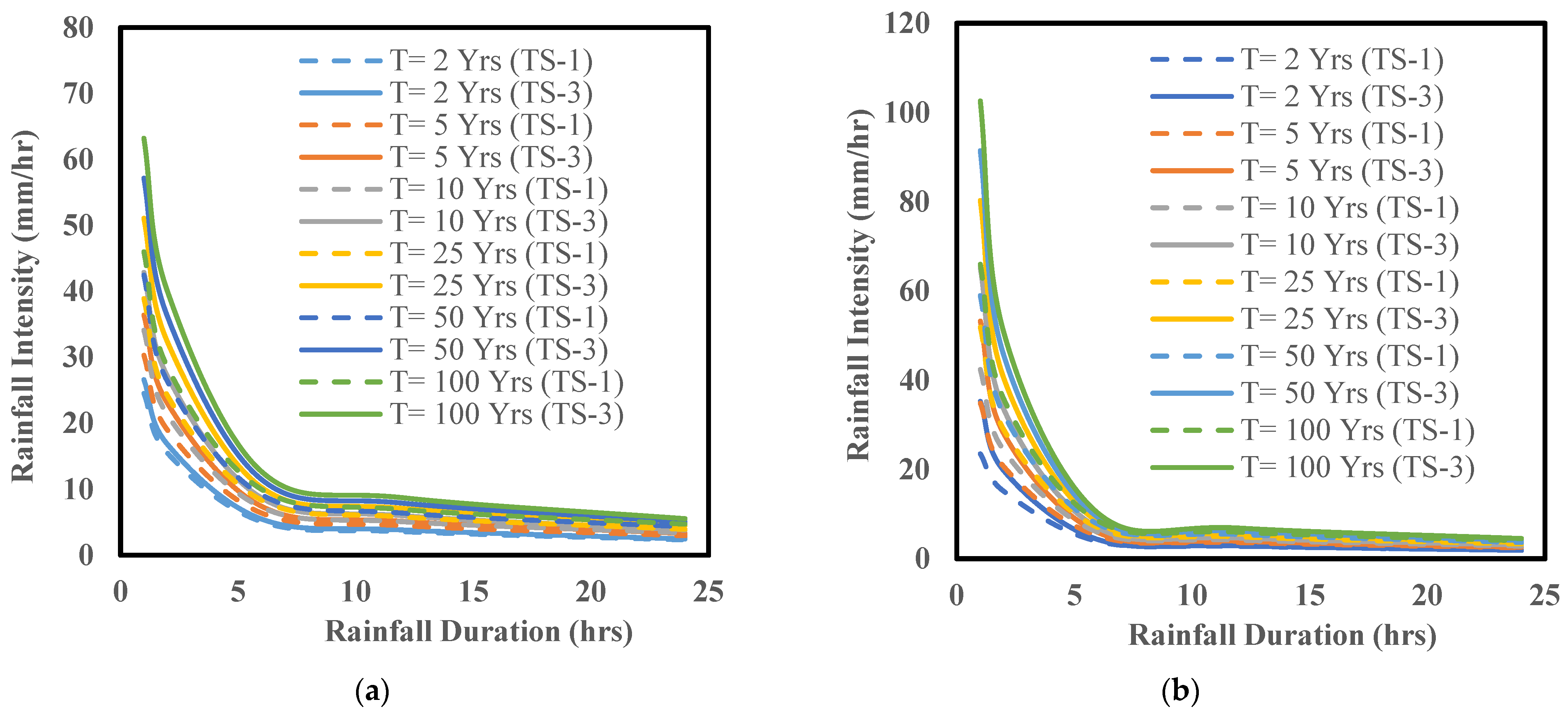

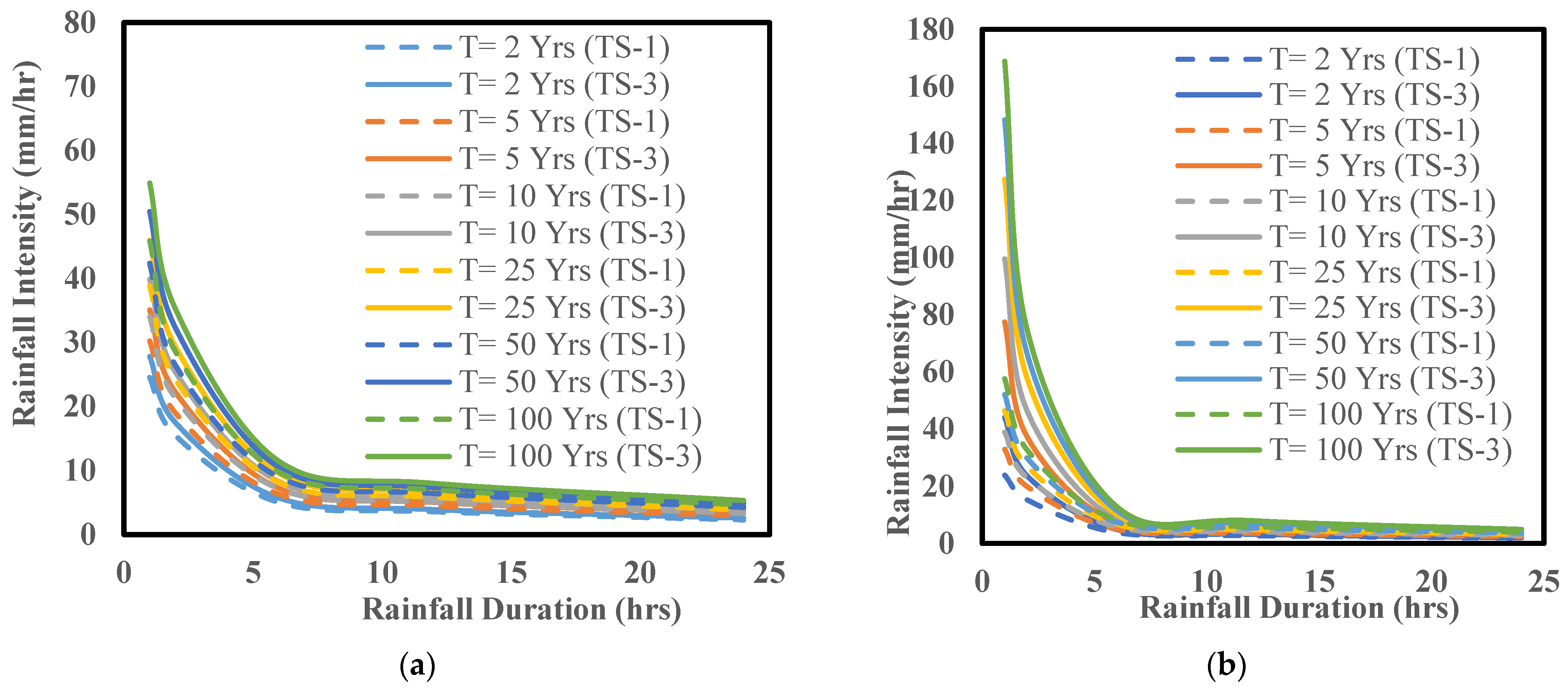





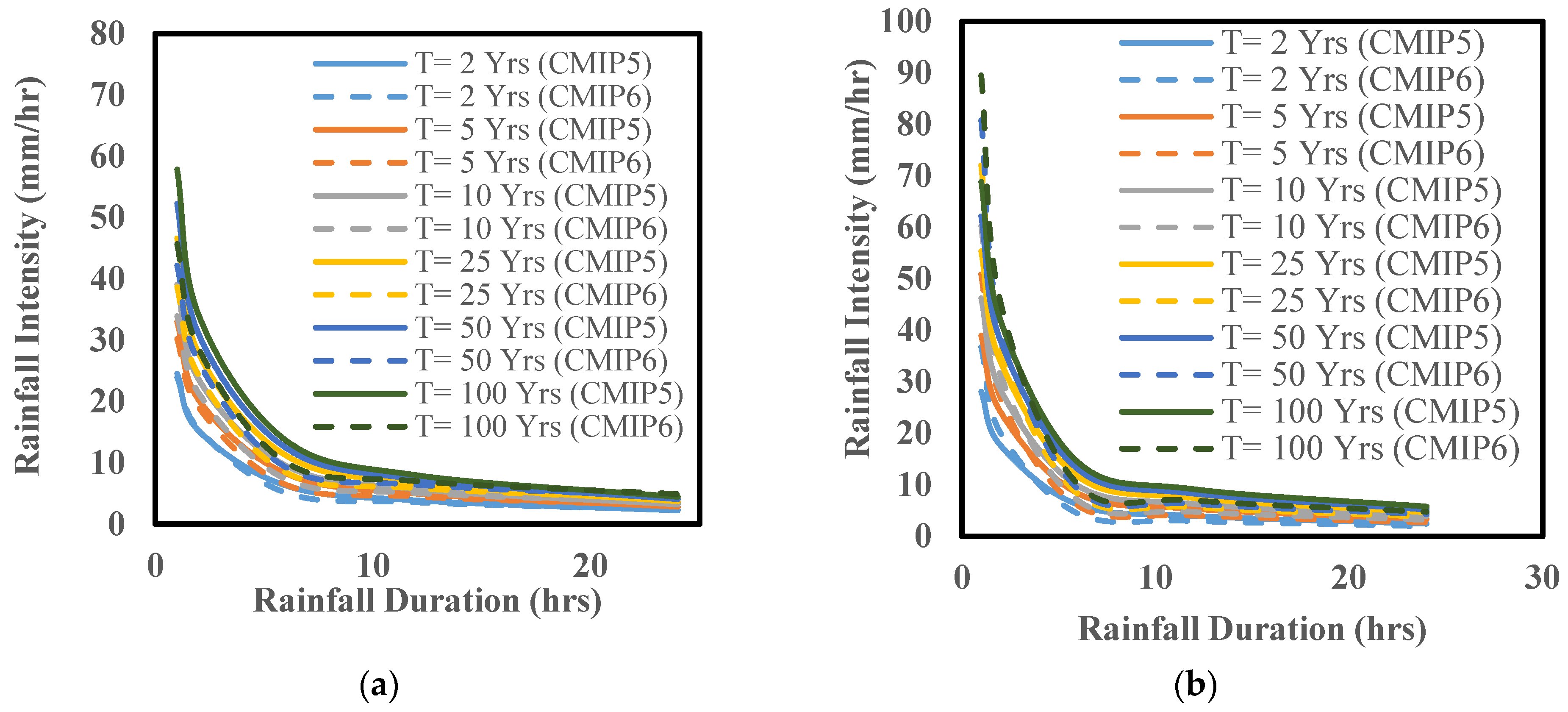

| CMIP5 | ||||||
| Source | Source ID | GCM | Scenario | Grid | Frequency | Resolution |
| NA-CORDEX | WRF | GFDL-ESM2M | hist, RCP8.5 | NAM-22 | 1 h | 0.44° × 0.44° |
| HadGEM2-ES | ||||||
| MPI-ESM-LR | ||||||
| CMIP6 | ||||||
| Source | Source ID | Experiment ID | Variant Label | Frequency | Resolution | |
| WRCP | MIROC6 | hist, ssp126, ssp245, ssp370, ssp585 | r1i1p1f1 | 1 h | 1.4° × 1.4° | |
| CNRM-CM6-1-HR | r1i1p1f2 | 0.5° × 0.5° | ||||
| CNRM-ESM2-1 | r1i1p1f2 | 1.4° × 1.4° | ||||
| Statistics | CMIP5 Models | ||||||
| Observed | GFDL-ESM2M | HadGEM2-ES | MPI-ESM-LR | ||||
| Before | After | Before | After | Before | After | ||
| Average (mm) | 2.67 | 4.04 | 2.6 | 3.06 | 2.68 | 3.56 | 2.51 |
| St. Dev. (mm) | 6.62 | 7.24 | 6.78 | 7.11 | 6.58 | 6.79 | 6.39 |
| CMIP6 Models | |||||||
| Statistics | Observed | GFDL-ESM2M | HadGEM2-ES | MPI-ESM-LR | |||
| Before | After | Before | After | Before | After | ||
| Average (mm) | 2.67 | 3.04 | 2.69 | 3.36 | 2.65 | 3.30 | 2.68 |
| St. Dev. (mm) | 6.62 | 6.06 | 6.77 | 6.60 | 6.71 | 6.13 | 6.77 |
| Statistics | CMIP5 Models | ||||||
| Observed | GFDL-ESM2M | HadGEM2-ES | MPI-ESM-LR | ||||
| Before | After | Before | After | Before | After | ||
| Average (mm) | 1.97 | 3.65 | 1.93 | 3.84 | 2.17 | 4.01 | 2.35 |
| St. Dev. (mm) | 5.40 | 7.06 | 5.66 | 7.64 | 6.52 | 8.05 | 7.23 |
| CMIP6 Models | |||||||
| Statistics | Observed | GFDL-ESM2M | HadGEM2-ES | MPI-ESM-LR | |||
| Before | After | Before | After | Before | After | ||
| Average (mm) | 1.97 | 3.16 | 1.43 | 3.27 | 1.44 | 3.10 | 1.44 |
| St. Dev. (mm) | 5.40 | 6.29 | 4.90 | 6.11 | 4.93 | 6.24 | 4.87 |
Disclaimer/Publisher’s Note: The statements, opinions and data contained in all publications are solely those of the individual author(s) and contributor(s) and not of MDPI and/or the editor(s). MDPI and/or the editor(s) disclaim responsibility for any injury to people or property resulting from any ideas, methods, instructions or products referred to in the content. |
© 2023 by the authors. Licensee MDPI, Basel, Switzerland. This article is an open access article distributed under the terms and conditions of the Creative Commons Attribution (CC BY) license (https://creativecommons.org/licenses/by/4.0/).
Share and Cite
Mainali, S.; Sharma, S. Climate Change Effects on Rainfall Intensity–Duration–Frequency (IDF) Curves for the Lake Erie Coast Using Various Climate Models. Water 2023, 15, 4063. https://doi.org/10.3390/w15234063
Mainali S, Sharma S. Climate Change Effects on Rainfall Intensity–Duration–Frequency (IDF) Curves for the Lake Erie Coast Using Various Climate Models. Water. 2023; 15(23):4063. https://doi.org/10.3390/w15234063
Chicago/Turabian StyleMainali, Samir, and Suresh Sharma. 2023. "Climate Change Effects on Rainfall Intensity–Duration–Frequency (IDF) Curves for the Lake Erie Coast Using Various Climate Models" Water 15, no. 23: 4063. https://doi.org/10.3390/w15234063
APA StyleMainali, S., & Sharma, S. (2023). Climate Change Effects on Rainfall Intensity–Duration–Frequency (IDF) Curves for the Lake Erie Coast Using Various Climate Models. Water, 15(23), 4063. https://doi.org/10.3390/w15234063






